标签:des style class blog code http
The 2-3 tree is also a search tree like the binary search tree, but this tree tries to solve the problem of the unbalanced tree.
Imagine that you have a binary tree to store your data. The worst possible case for the binary tree is that all of the data is entered in order. Then the tree would look like this:
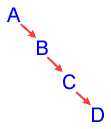
This tree has basically turned into a linked list. This is definitely a problem, for with a tree unbalanced like this, all of the advantages of the binary search tree disappear: searching the tree is slow and cumbersome, and there is much wasted memory because of the empty left child pointers.
浪费了存储空间。
The 2-3 tree tries to solve this by using a different structure and slightly different adding and removing procedure to help keep the tree more or less balanced. The biggest drawback with the 2-3 tree is that it requires more storage space than the normal binary search tree.
The 2-3 tree is called such because the maximum possible number of children each node can have is either 2 or 3. This makes the tree a bit more complex, so I will try to explain as much as possible.
One big difference with the 2-3 tree is that each node can have up to two data fields. You can see the three children extending from between the two data fields.

Thus, the tree is set up in the following manner:
Now, take a look at the implementation of a 2-3 tree:
class twoThreeTree { public: twoThreeTree(void); // Constructor ~twoThreeTree(void); // Destructor void add(int item); // Adds an item void search(int item); // Searches for an item private: twoThreeNode *root; // Pointer to root node // Private helper functions go here }; class twoThreeNode { public: int firstData, secondData; // Two data fields // The three child nodes twoThreeNode *first, *second, *third; // This next one is quite useful. It aids // moving around the tree. It is a pointer // to the parent of the current node. twoThreeNode *parent; };
You can see that this tree, unlike the binary search tree or the heap tree, has no remove() function. It is possible to program a remove function, but it generally isn‘t worth the time or the effort.
This tree will be a bit harder to implement than the binary search tree just because of the complexity of the node. Still, the add() function algorithm isn‘tthat difficult, and a step-by-step progression through the algorithm helps enormously.
First, to add an item, find the place in the tree for it. This is very much the same as in the binary search tree: just compare and move down the correct link until leaf node is reached.
Once at the leaf node, there are three basic cases for the add() function:
Doing a few small 2-3 trees by hand helps to understand this algorithm. Remember to check and hold to the rules governing the 2-3 tree! It can get ugly if they are ignored, especially with the last one.
Using some recursive helper functions as well as that miraculous parent variable will help ease the pain of programming this tree.
转自:http://www.cprogramming.com/tutorial/computersciencetheory/twothree.html
发现前面说的比较啰嗦,看wikipedia一目了然http://en.wikipedia.org/wiki/2%E2%80%933_tree
2-3tree有两种形式:


查找:
在进行2-3树的平衡之前,我们先假设已经处于平衡状态,我们先看基本的查找操作。
2-3树的查找和二叉查找树类似,要确定一个树是否属于2-3树,我们首先和其跟节点进行比较,如果相等,则查找成功;否则根据比较的条件,在其左中右子树中递归查找,如果找到的节点为空,则未找到,否则返回。查找过程如下图
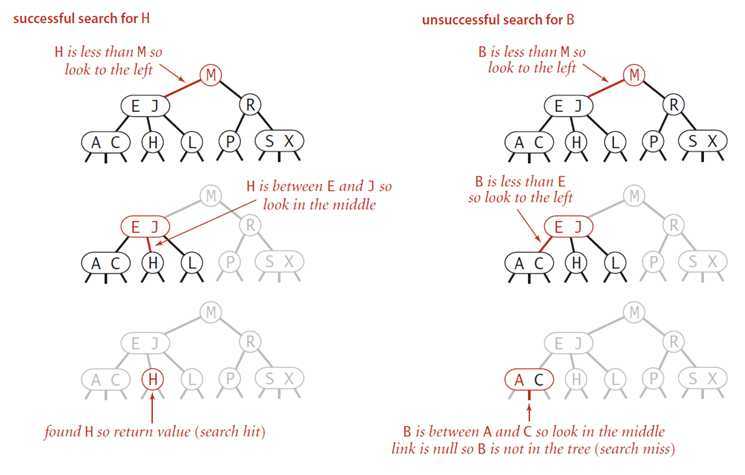
往2-3树中插入元素和往二叉查找树中插入元素一样,首先要进行查找,然后将节点挂到未找到的节点上。2-3树之所以能够保证在最差的情况下的效率的原因在于其插入之后仍然能够保持平衡状态。如果查找后未找到的节点是一个2-node节点,那么很容易,我们只需要将新的元素放到这个2-node节点里面使其变成一个3-node节点即可。但是如果查找的节点结束于一个3-node节点,那么可能有点麻烦。

往一个3-node节点插入一个新的节点可能会遇到很多种不同的情况,下面首先从一个最简单的只包含一个3-node节点的树开始讨论。
只包含一个3-node节点
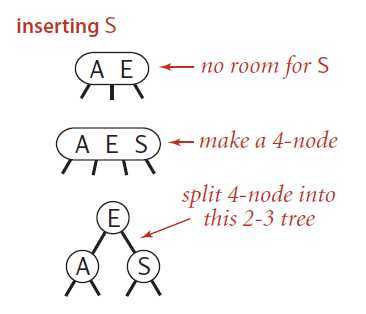
如上图,假设2-3树只包含一个3-node节点,这个节点有两个key,没有空间来插入第三个key了,最自然的方式是我们假设这个节点能存放三个元素,暂时使其变成一个4-node节点,同时他包含四个子节点。然后,我们将这个4-node节点的中间元素提升,左边的节点作为其左节点,右边的元素作为其右节点。插入完成,变为平衡2-3查找树,树的高度从0变为1。
节点是3-node,父节点是2-node
和第一种情况一样,我们也可以将新的元素插入到3-node节点中,使其成为一个临时的4-node节点,然后,将该节点中的中间元素提升到父节点即2-node节点中,使其父节点成为一个3-node节点,然后将左右节点分别挂在这个3-node节点的恰当位置。操作如下图:
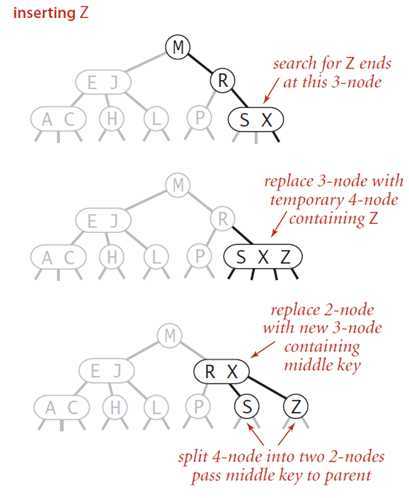
节点是3-node,父节点也是3-node
当我们插入的节点是3-node的时候,我们将该节点拆分,中间元素提升至父节点,但是此时父节点是一个3-node节点,插入之后,父节点变成了4-node节点,然后继续将中间元素提升至其父节点,直至遇到一个父节点是2-node节点,然后将其变为3-node,不需要继续进行拆分。
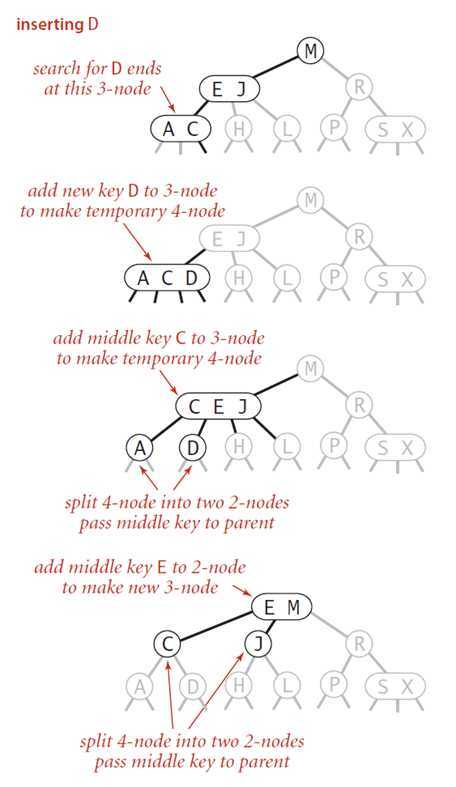
根节点分裂
当根节点到字节点都是3-node节点的时候,这是如果我们要在字节点插入新的元素的时候,会一直查分到跟节点,在最后一步的时候,跟节点变成了一个4-node节点,这个时候,就需要将跟节点查分为两个2-node节点,树的高度加1,这个操作过程如下:
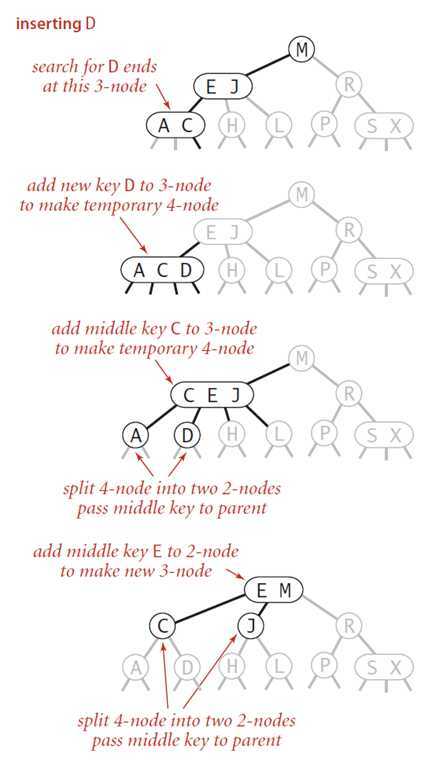
本地转换
将一个4-node拆分为2-3node涉及到6种可能的操作。这4-node可能在跟节点,也可能是2-node的左子节点或者右子节点。或者是一个3-node的左,中,右子节点。所有的这些改变都是本地的,不需要检查或者修改其他部分的节点。所以只需要常数次操作即可完成2-3树的平衡。
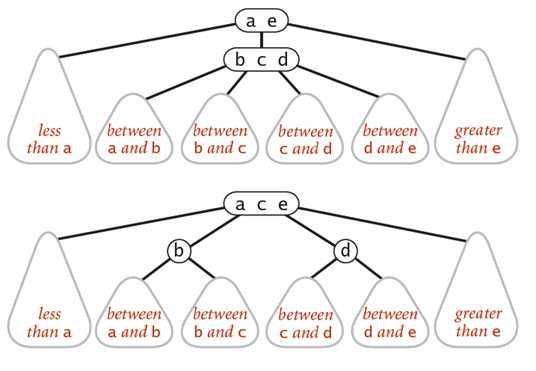
性质
这些本地操作保持了2-3树的平衡。对于4-node节点变形为2-3节点,变形前后树的高度没有发生变化。只有当跟节点是4-node节点,变形后树的高度才加一。如下图所示:
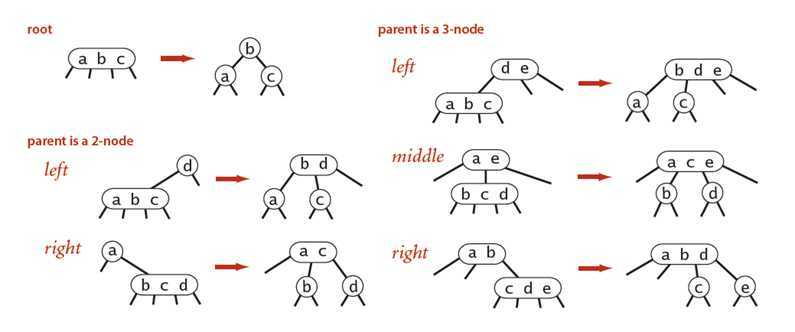
转自:http://www.cnblogs.com/yangecnu/p/3624443.html
关于2-3tree的一个ppt:http://www.docin.com/p-621379239.html
“B-树”的“2-3树”的题目,望前辈指导!!!
题目是:
从空树开始,依次输入20,30,50,52,60,68,70,画出建立2-3树的过程。并分别画出删除50和68后的B-树状态。
书上说:通常取最小值m=3(度数,阶),此时B-树中每个内部结点可以有2或3个孩子,故将这种3阶的B-树称之为2-3树。
答案是:
答案给的是:
1〉 [20]
2〉 [20,30]
3〉 [30]
/ \
[20] [50]
4〉 [30]
/ \
[20] [50,52]
5〉 [30,52]
/ | \
[20] [50] [60]
6〉 [30,52]
/ | \
[20] [50] [60,68]
7〉 [30,52,68]
/ | \
[20] [50] [60,70]
8〉 [52]
/ \
[30] [68]
/ \ / \
[20][50][60][70]
转自:http://www.myexception.cn/arithmetic/256189.html
更多:
http://philoscience.iteye.com/blog/1401962
标签:des style class blog code http
原文地址:http://www.cnblogs.com/youxin/p/3806213.html